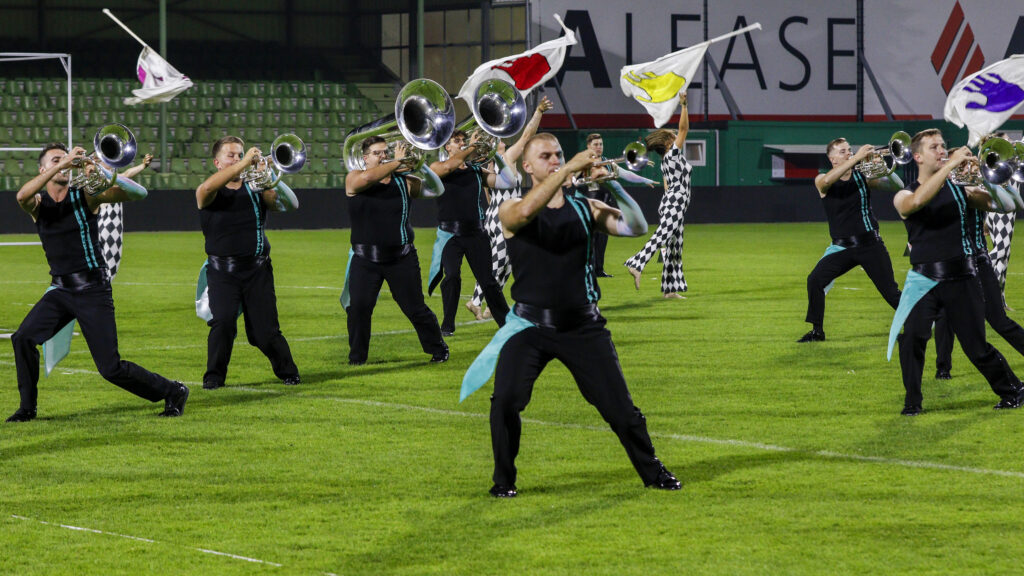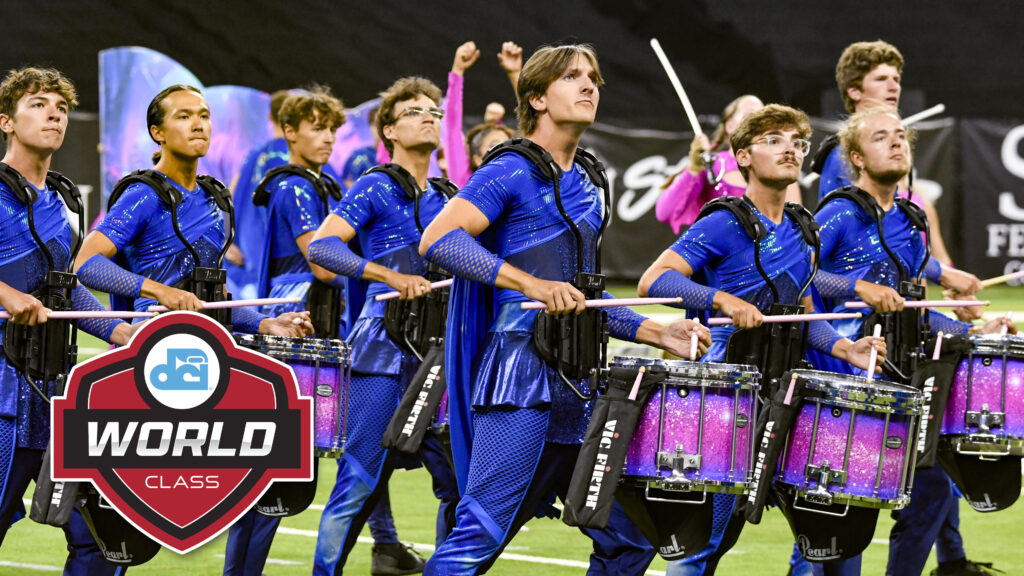Clarke Williams has been one of our best known and best loved visual judges for many, many years. He was asked to share his story for “Fanfare.” But first, here is a small sample extracted from what DCI Hall of Fame member Gene Monterestelli wrote about Clarke, when Clarke was nominated for the DCI Hall of Fame. (Clarke was inducted in the Class of 1999.)
INTEGRITY:
I’ve known Clarke for over 30 years. My first contact with him was as an instructor. With Clarke, then and now, you know you are going to get an unbiased reading. The performance of the night is what determines the score, not the zip code, the color of the uniform, or “status” in the activity.
STUDENT:
From the early years to now, Clarke has always been a student of the activity. We have had many discussions over the years as to the “why” of the decision process. His concern has always been to continue on the “up” of the learning curve and not that scores “line up.” Anyone who has ever dealt with Clarke in the critique knows he is always interested in what you have to say.
STAMINA:
He is the only judge left in the DCI arena from the first championship. To last this long in our highly competitive activity shows both his interest in the activity and that he contributes. And now, we’ll hear from Clarke, himself. I have been involved in drum corps since I was 8 years old. I stayed with and aged out of the same corps. I marched with the St. Ann’s Cadets from Fairlawn, N.J., which later became the Fairlawn Cadets when it was not favorable for a church to sponsor a drum corps. I competed against St. Vinnies, Blessed Sacrament, Holy Name, etc. I also had the opportunity to march with them, but chose to age out of the corps I started with. Shortly thereafter, I started to teach drum corps, winter guard and high school bands. It was not long after I aged out that I applied to the Eastern States Judges Association and the Mid Atlantic Judges Association to become a judge. It was a long process, but a good one. At the table for my oral test were Dr. Bernard Baggs, Moe Kazazian, Mickey Petrone, Cal Denniston, Carmen Cluna and others. I now fast forward to judging the first DCI championships in Whitewater, Wis., and being on the same panel with Earl Joyce, with Rick Mass as the judge coordinator/chief judge. I was in great company then, as I am now. There are two things that are a sense of motivation for me in the activity; the first is the performer, and second, the relationships and friends I’ve made not only in judging but in the activity in general. Whitewater, Wisconsin, is where it all started. I think it might have been the second or third year in Whitewater that the judges stayed in the dorms. What a rush that was and today it is a fond memory … seeing corps after corps practicing on any patch of grass or concrete they could find, and waking up in the early morning to hear a drum line outside your window. It was a valuable experience being in the same environment with the corps. Seeing the performers working so hard in those last few days before championship was a source of inspiration and provided energy for us as judges. It was an experience that I fear will not be felt again because judges are so far removed from the day-to-day growth of the performer, except as it is witnessed at a performance on a given evening. I want to now focus on judging as a visual performance judge. In the early years it was marching and maneuvering and there were two M&M judges on the field. We were on the field to record errors, and that was the extent of our involvement. Judging in the 1970s was simply a focus on space, line and time … while in the 1990s and in our present state it is a focus on the performer, listening and viewing all that they achieve in space, line and time. (Visual judges listen and music judges see.) It has been wonderful growth, growth brought about by a vision from Donald Angelica. What is attempted and achieved has been so positive in that there are no bounding lines on creativity and expressiveness. The activity is always moving forward. There is a judging system in place that allows and encourages that. The high levels of creativity and excellence are usually a step ahead of where we as judges are at that moment. We were then and are today learning from the designers, technicians and performers as they define the activity. I can remember in 1983 being in Miami and I was assigned to the prelims, (or semifinals, as we know it today). It was the year when we were on the verge of going from a “tick” system to an evaluation system. They put a microphone and camera on me as I walked about the field evaluating space, line and time. I was also discussing the achievement of the performer and acknowledging their literature at that moment. We were still “ticking” at the same time and acknowledging the achievement by the performer as they moved through space, line and time. I took great pride in that, as it was the link to what it is we see view and experience today. We go back now to 1972 in Whitewater. The emphasis then, as it is now, is excellence. That is what makes drum corps, winter guard and marching band today so attractive, and it is what everyone remembers. In the early years, it wasn’t so much creativity that scored well as much as it was “clean everything and what we can’t clean we will hide from the judges.” Corps staffs would say, “Do not take a risk unless we can hide it, or at best clean it.” That was a common focus in the visual community back then. I can remember at critiques, which were held at every show, that staff members would go to the critique, wanting to go over every “tick” mark on the score sheet. (A “tick” had a value of a tenth of a point.) The scores then were measured on how few “ticks” you had on your score sheet. In the years that followed, the natural progression then was for the judge to record the “tick” and indicate who the “tick” was on; soprano, baritone, etc. That made the critique even more productive and the accountability of the judge to the system became quite clear. The error was in the space the performer occupied or the line they were in. The individual errors came from step-offs, timing of turns, etc. The other captions had similar accountability: For example, the General Effect captions had captions like entrance, color presentation and exit. There were defined parameters and as the corps got better, it was a natural progression to want to go beyond those parameters or step outside the lines. An example would be the elimination of the concert set. All corps would come to a halt and play a production that was called the “concert.” Then someone got the idea of “let’s not do a concert and the judges will have to give us more credit because we are moving and playing more than the other corps.” That might be an oversimplification, but not by much. The progression to where we are now has been nothing short of remarkable. I say that as I was there when we didn’t study what the performer did, and we did not care what the performer did. We simply looked to see if there were errors in spacing and in lines, and were concerned about the individual errors of timing, heels at a halt, etc. I am sure many of the readers can relate to those times, and at the same time, there are many readers that relate to where we are today. We look to the performer acknowledging what it is they do, how well they understand how to do it, and then, of course, how well they do it. Today, we acknowledge their individual composition when judging performance. We perceive and acknowledge the technique or lack thereof, and we look to uniformity as they perform with others. Uniformity is still a consideration as it was back in 1972. It is simply amazing and very rewarding for to me to acknowledge to a performer what they are achieving, be it a brass player, percussionist or a member of the color guard. Yes, there is an acknowledgement by the judge of what it is they are playing, what they are doing with equipment and what performers (not limited to guard members) are doing with their body. It is focusing on all of the simultaneous responsibilities being demonstrated throughout their performance. I am sure there will be progress in the next 30 years, but I feel the strides made by the designer, technician and performer alike over the past 30 years have been remarkable. That achievement has brought the judging system to what it is today … study of and an appreciation of what the unit does, as well as how they demonstrate — through technique — their highest level of excellence. There is opportunity in this activity for every unit and every performer to achieve at their highest level of excellence. The activity, whether it be drum corps, color guard, marching percussion or marching band, is not about the top five scores or top ten scores in the activity. It is about achievement … achievement by an individual working in a team environment. It starts with the first minute they start to learn their program, to the next step where they develop an understanding of their program and the techniques needed to perform their program. The moment of triumph has them bringing their performance to life through their understanding, and more importantly, their passion for their performance. It is when I can say to the performer that I felt what they felt. I can say that since all of this is driven by and based in music, “they have become the music that they are.” This has been — and continues to be — a remarkable journey for me, and it has nothing to do with being around for so long. Rather, it is and will continue to be a wonderful journey because of what I experience from the performer in each and every performance. Thank you. J. Clarke Williams





